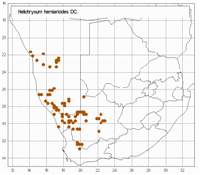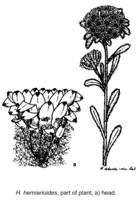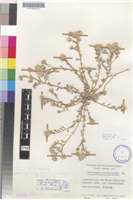Diagnostic characters:
Prostrate herbSmall compact flower headsLeaves beneath flower head very woollyBracts whiteDescription:
Annual herb with a woody taproot, primary stem very short, erect, subsequent branches many from the base, prostrate, ascending or erect, mostly 30�200 mm long, simple or sparingly to well-branched, slender, cobwebby, distantly or closely leafy. Leaves mostly 4�12 x 2�7 mm, linear, oblong-obovate, obovate or spathulate, base much narrowed, apex rounded to subacute, loosely white-woolly, sometimes glabrescent, glandular. Heads homogamous or heterogamous, campanulate, c. 4�5 x 4�6 mm across the radiating bracts, many crowded in terminal glomerules surrounded by a few leaves. Involucral bracts in 5�6 series, subequal, loosely imbricate, outer pellucid, often tinged red-brown, webbed with wool, inner acute, subacute or obtuse, tips opaque or subopaque snow-white, sometimes tipped red-brown, sometimes with a reddish patch above the stereome, or sometimes the whole bract suffused pink, equaling or slightly exceeding the flowers, radiating. Receptacle smooth or nearly so. Flowers 9�42, 0�4 female, 9�40 homogamous. Achenes 0.75 mm long, obscurely ribbed, glabrous or with myxogenic duplex hairs. Pappus bristles many, equaling corolla, scabrid, bases with minute patent cilia, not cohering.
Flowering recorded between March and December, but peak flowering from July to September.
Distribution:
In the more arid parts of the Cape from about Ceres N. and NE. to the environs of Prieska and Upington, Namaqualand and the western part of Namibia about as far north as the Omaruru river; common in open sandy or stony places and in open thorn scrub on sand, often in watercourses or depressions.
Succulent Karoo, Nama Karoo and Savanna Biomes.
Notes:
Recorded as eaten by stock.
As already noted by Merxm�ller (F.S.W.A. 139: 94, 1967) three groups can be distinguished within H. herniarioides. Plants of the northernmost group (Okahandja, Windhoek, Rehoboth and Nauchas degree squares) are prostrate, ascending or erect, leaves 1�2 (�3) mm at their broadest, heads homogamous, 19�29 flowers, involucral bracts obovate or rotund, very obtuse, white or brown and white, sometimes innermost pink, ovaries always hairy (e.g. Codd 5733, PRE; WIND; Dinter 7767, M; WIND; Giess 13595 PRE; WIND; Nordenstam. 3662, M; S).
Plants from L�deritz and Aus degree squares are prostrate, leaves mostly 3�4 mm at their broadest, heads homogamous, 9�25 flowers, involucral bracts more or less lanceolate, acute to obtuse, white or brown and white, inner often pink, ovaries hairy or glabrous (Dinter 4096, M fragment, PRE; SAM; Merxm�ller & Giess 2841, PRE; WIND).
From roughly the 27th parallel southwards into the Cape, plants are prostrate, leaves mostly 3�7 mm broad, heads homogamous or heterogamous with 0�4 female flowers, 9�40 homogamous flowers, involucral bracts often narrow, sometimes broad, acute to obtuse, mostly white or brown and white, rarely inner pink, ovaries hairy or glabrous (Acocks 14452, PRE; Giess 13752, PRE; WIND; Giess 9458, WIND; Compton 7919, NBG).
A fourth variant of H. herniarioides (not of H. marlothianum: see Merxm�ller l.c. 95) comprises plants from Uis and Swakopmund degree squares (Galpin & Pearson 7644, K; PRE; SAM; Giess 3573, M, PRE; Giess, Volk & Bleissner 5781, M; PRE; Marloth 1248, M; PRE; SAM; Merxm�ller & Giess 1754, M). They differ from the other northern group mentioned above by their more acute bracts and glabrous ovaries. A plant from further east, in Sandfontein degree square (Wilman 15347, BOL; SAM), also belongs here. The stems in young plants are simple or subsimple, prostrate and distantly leafy; the stems of older plants are loosely branched and are possibly erect.
The complexities of H. herniarioides cannot be unraveled in the herbarium.
H. herniarioidescan be confused with H. gariepinum: heads are 4�5 mm long with 9�40 flowers in H. herniarioides, 6�7 mm long with 40�100 flowers in H. gariepinum. Heads are always heterogamous in H. gariepinum, and the involucral bracts are mostly white with the inner often rosy. See also under H. marlothianum.
Taxonomy:
Literature:
Helichrysum herniarioides DC., Prodr. 6: 170 (1838); Harv. in F. C. 3: 215 (1865); Moeser in Bot. Jb. 44: 304 (1910); Merxm., F.S.W.A. 139: 94 (1967).
Type:
Lectotype: Cape, Silverfontein, Dr�ge (G-DC; BM; PRE; S; SAM; TCD, isolecto.).
Synonym(s):
Gnaphalium herniarioides (DC.) Sch. Bip. in Bot. Ztg 3: 169 (1845).
G. indicum sensu Dinter in Fedde, Repert. 17: 311 (1921), non L.
Vouchers:
Galpin & Pearson 7644 (K; PRE; SAM); Giess 3573 (M, PRE); Giess, Volk & Bleissner 5781 (M; PRE); Marloth 1248 (M; PRE; SAM); Merxm�ller & Giess 1754 (M): Acocks 14452 (PRE); Giess 13752 (PRE; WIND); Giess 9458 (WIND); Compton 7919 (NBG); Wilman 15347 (BOL; SAM); Dinter 4096 (M fragment, PRE; SAM); Merxm�ller & Giess 2841 (PRE; WIND).


